CPCCBC5009A Assessment 4: Design of Building Systems - Part A to D
VerifiedAdded on 2022/09/08
|8
|1662
|17
Report
AI Summary
This report details the design considerations for several building systems within a medium-rise apartment complex. Part A focuses on the design of a fully vented sanitary system, emphasizing the importance of trap vents, branch vents, stack vents, and relief vents, while also including a stack work diagram and a water reticulation system. Part B presents a lighting system drawing. Part C proposes a Rheem 26L continuous flow hot water system, providing design specifications for optimal performance and energy efficiency, suitable for a residential apartment. The specifications include sizing parameters, energy ratings, and gas and water connection details. Finally, Part D recommends the Mitsubishi Electric MSZ-GL series for individual air conditioning systems, highlighting its energy efficiency, environmentally friendly refrigerant, and suitability for apartment installations. The report contrasts split and ducted systems, favoring split systems for their cost-effectiveness, particularly considering the project's budget constraints, and emphasizes the importance of fire safety during installation.
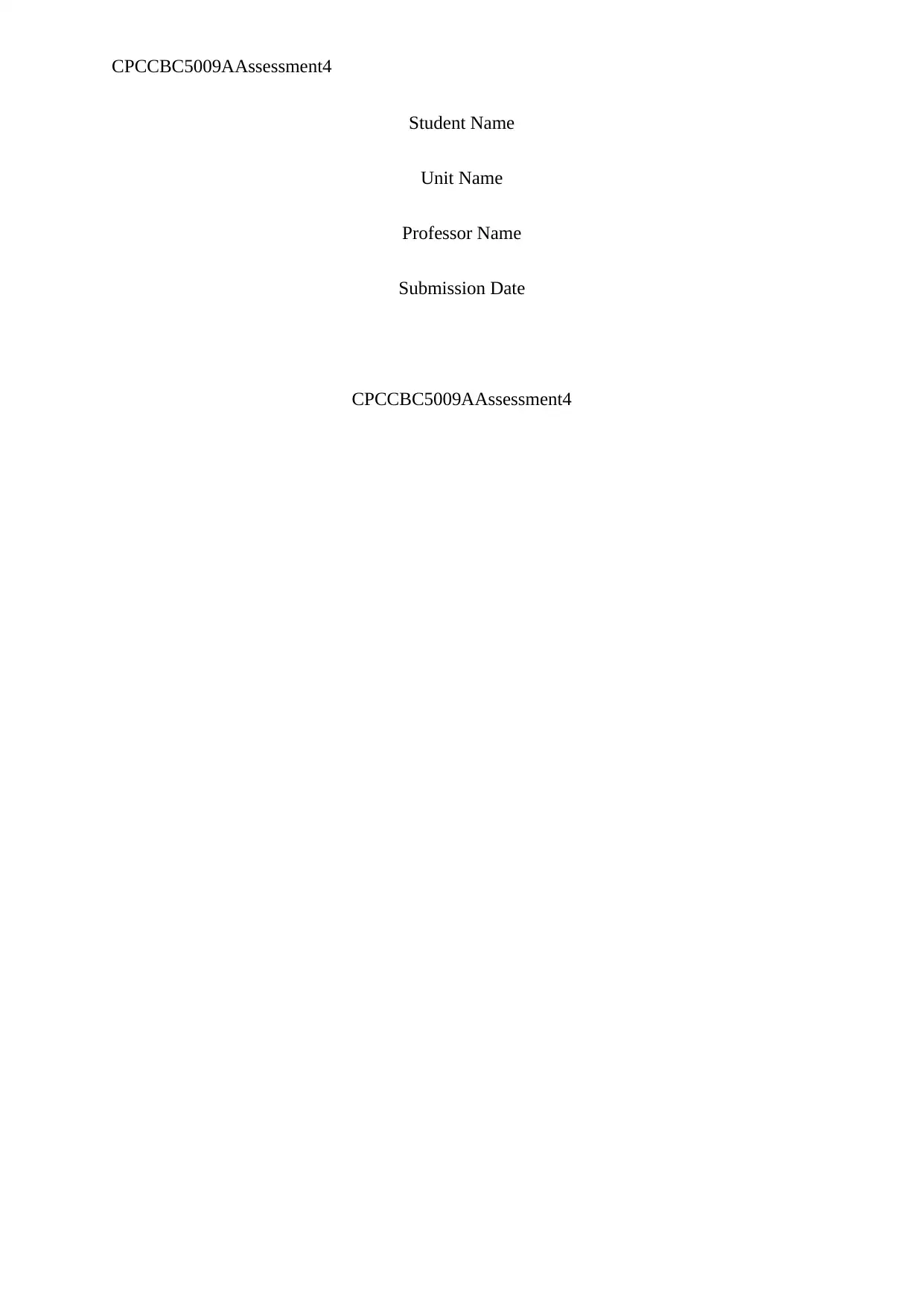
CPCCBC5009AAssessment4
Student Name
Unit Name
Professor Name
Submission Date
CPCCBC5009AAssessment4
Student Name
Unit Name
Professor Name
Submission Date
CPCCBC5009AAssessment4
Paraphrase This Document
Need a fresh take? Get an instant paraphrase of this document with our AI Paraphraser
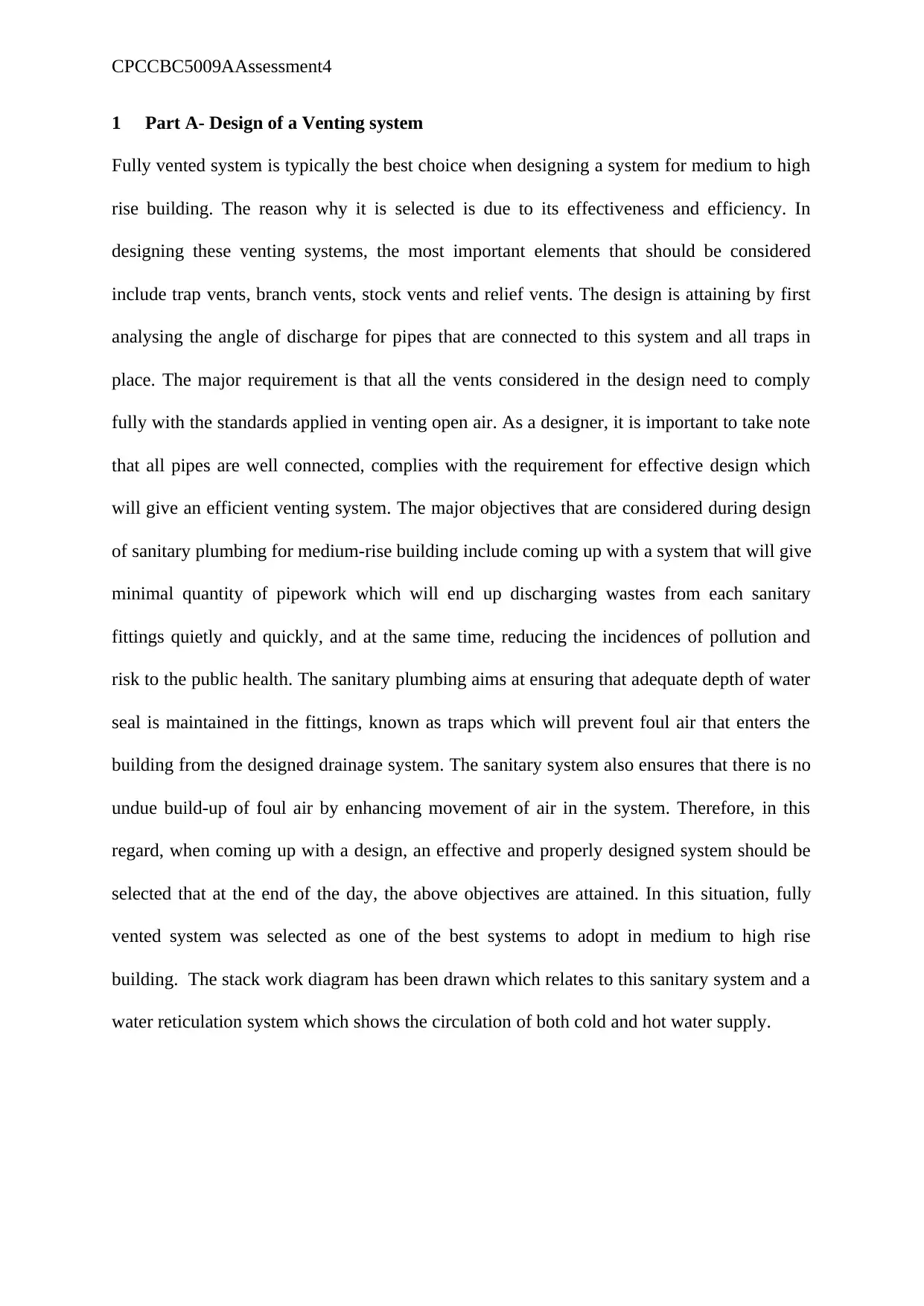
CPCCBC5009AAssessment4
1 Part A- Design of a Venting system
Fully vented system is typically the best choice when designing a system for medium to high
rise building. The reason why it is selected is due to its effectiveness and efficiency. In
designing these venting systems, the most important elements that should be considered
include trap vents, branch vents, stock vents and relief vents. The design is attaining by first
analysing the angle of discharge for pipes that are connected to this system and all traps in
place. The major requirement is that all the vents considered in the design need to comply
fully with the standards applied in venting open air. As a designer, it is important to take note
that all pipes are well connected, complies with the requirement for effective design which
will give an efficient venting system. The major objectives that are considered during design
of sanitary plumbing for medium-rise building include coming up with a system that will give
minimal quantity of pipework which will end up discharging wastes from each sanitary
fittings quietly and quickly, and at the same time, reducing the incidences of pollution and
risk to the public health. The sanitary plumbing aims at ensuring that adequate depth of water
seal is maintained in the fittings, known as traps which will prevent foul air that enters the
building from the designed drainage system. The sanitary system also ensures that there is no
undue build-up of foul air by enhancing movement of air in the system. Therefore, in this
regard, when coming up with a design, an effective and properly designed system should be
selected that at the end of the day, the above objectives are attained. In this situation, fully
vented system was selected as one of the best systems to adopt in medium to high rise
building. The stack work diagram has been drawn which relates to this sanitary system and a
water reticulation system which shows the circulation of both cold and hot water supply.
1 Part A- Design of a Venting system
Fully vented system is typically the best choice when designing a system for medium to high
rise building. The reason why it is selected is due to its effectiveness and efficiency. In
designing these venting systems, the most important elements that should be considered
include trap vents, branch vents, stock vents and relief vents. The design is attaining by first
analysing the angle of discharge for pipes that are connected to this system and all traps in
place. The major requirement is that all the vents considered in the design need to comply
fully with the standards applied in venting open air. As a designer, it is important to take note
that all pipes are well connected, complies with the requirement for effective design which
will give an efficient venting system. The major objectives that are considered during design
of sanitary plumbing for medium-rise building include coming up with a system that will give
minimal quantity of pipework which will end up discharging wastes from each sanitary
fittings quietly and quickly, and at the same time, reducing the incidences of pollution and
risk to the public health. The sanitary plumbing aims at ensuring that adequate depth of water
seal is maintained in the fittings, known as traps which will prevent foul air that enters the
building from the designed drainage system. The sanitary system also ensures that there is no
undue build-up of foul air by enhancing movement of air in the system. Therefore, in this
regard, when coming up with a design, an effective and properly designed system should be
selected that at the end of the day, the above objectives are attained. In this situation, fully
vented system was selected as one of the best systems to adopt in medium to high rise
building. The stack work diagram has been drawn which relates to this sanitary system and a
water reticulation system which shows the circulation of both cold and hot water supply.
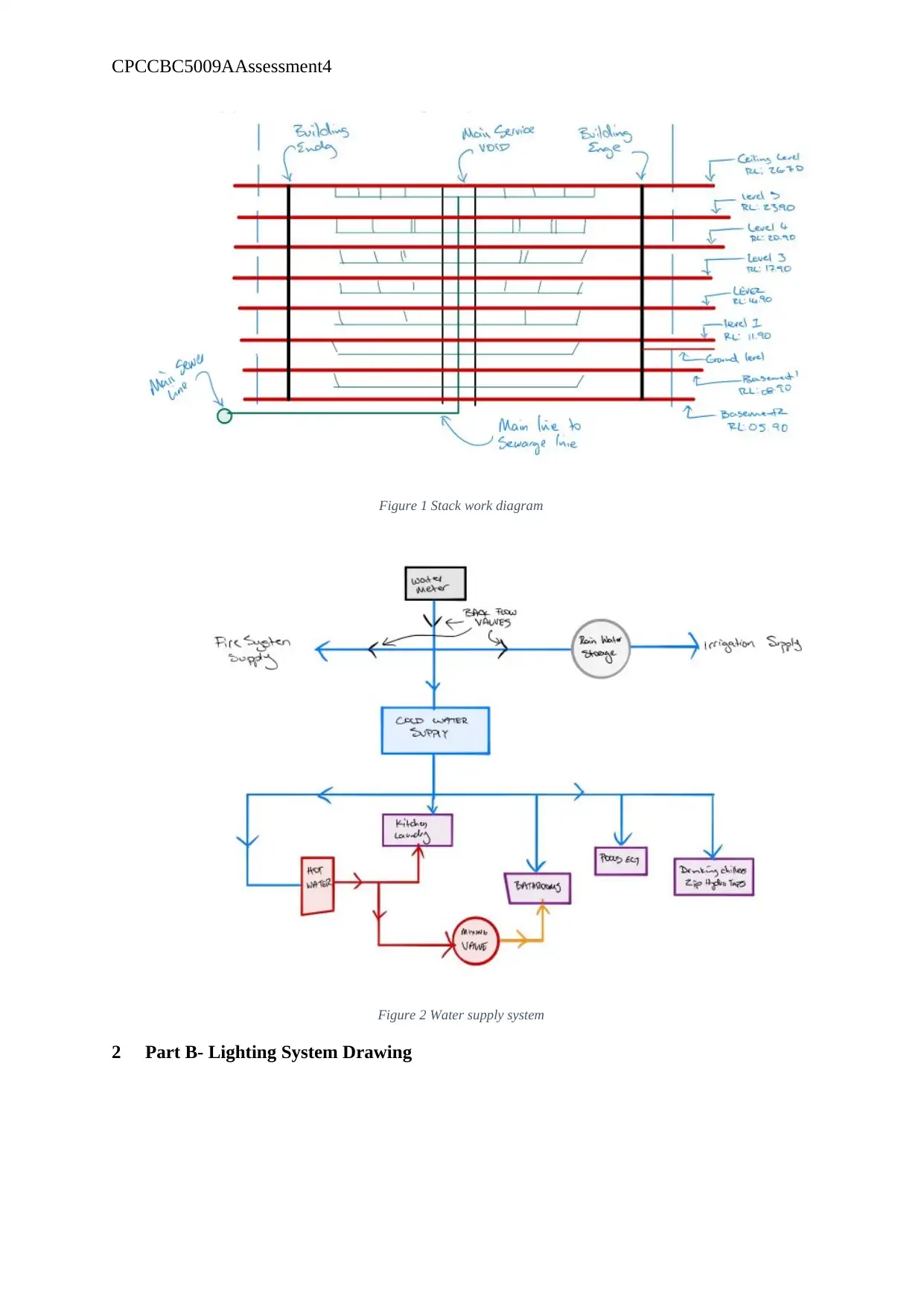
CPCCBC5009AAssessment4
Figure 1 Stack work diagram
Figure 2 Water supply system
2 Part B- Lighting System Drawing
Figure 1 Stack work diagram
Figure 2 Water supply system
2 Part B- Lighting System Drawing
⊘ This is a preview!⊘
Do you want full access?
Subscribe today to unlock all pages.

Trusted by 1+ million students worldwide
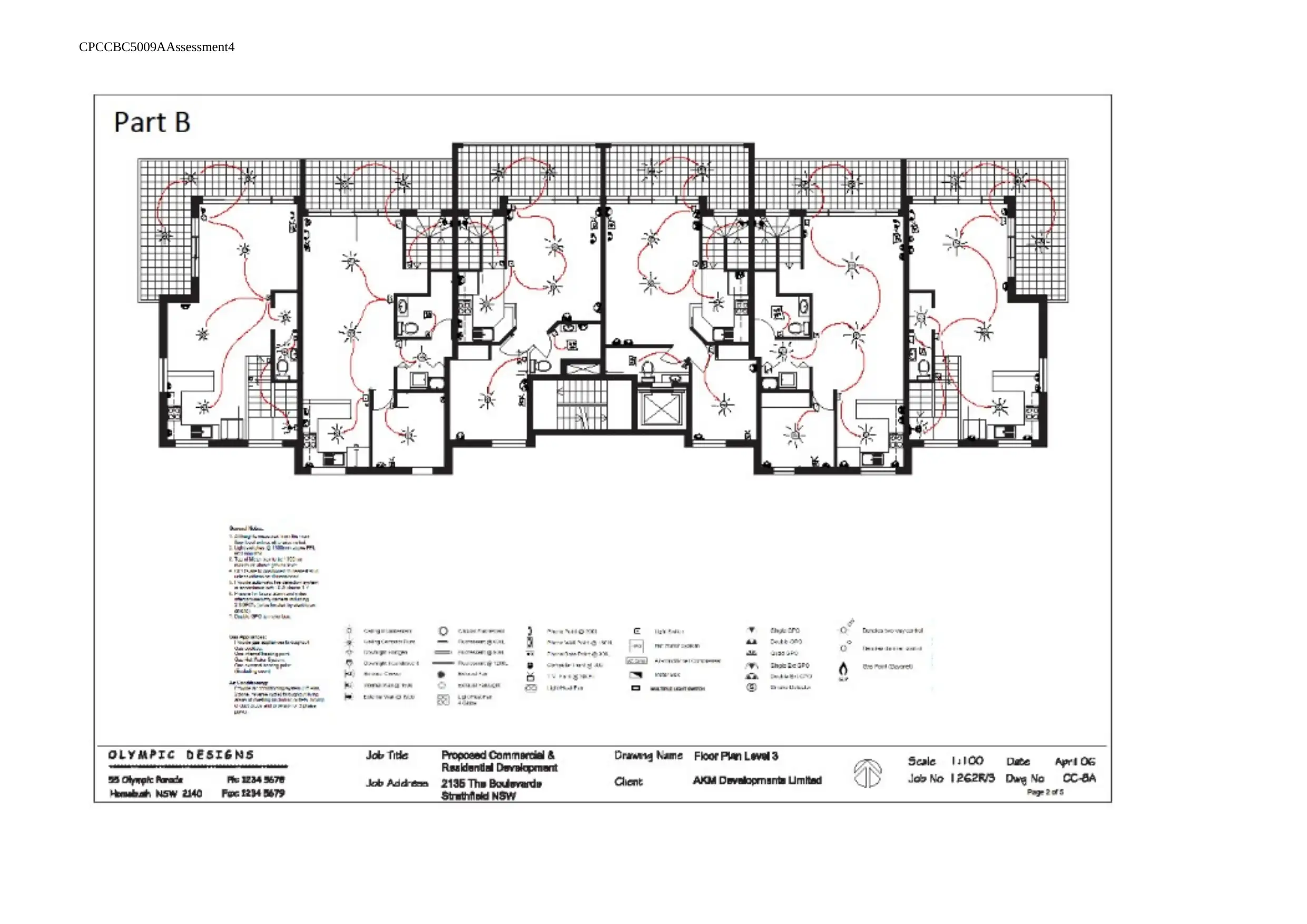
CPCCBC5009AAssessment4
Paraphrase This Document
Need a fresh take? Get an instant paraphrase of this document with our AI Paraphraser
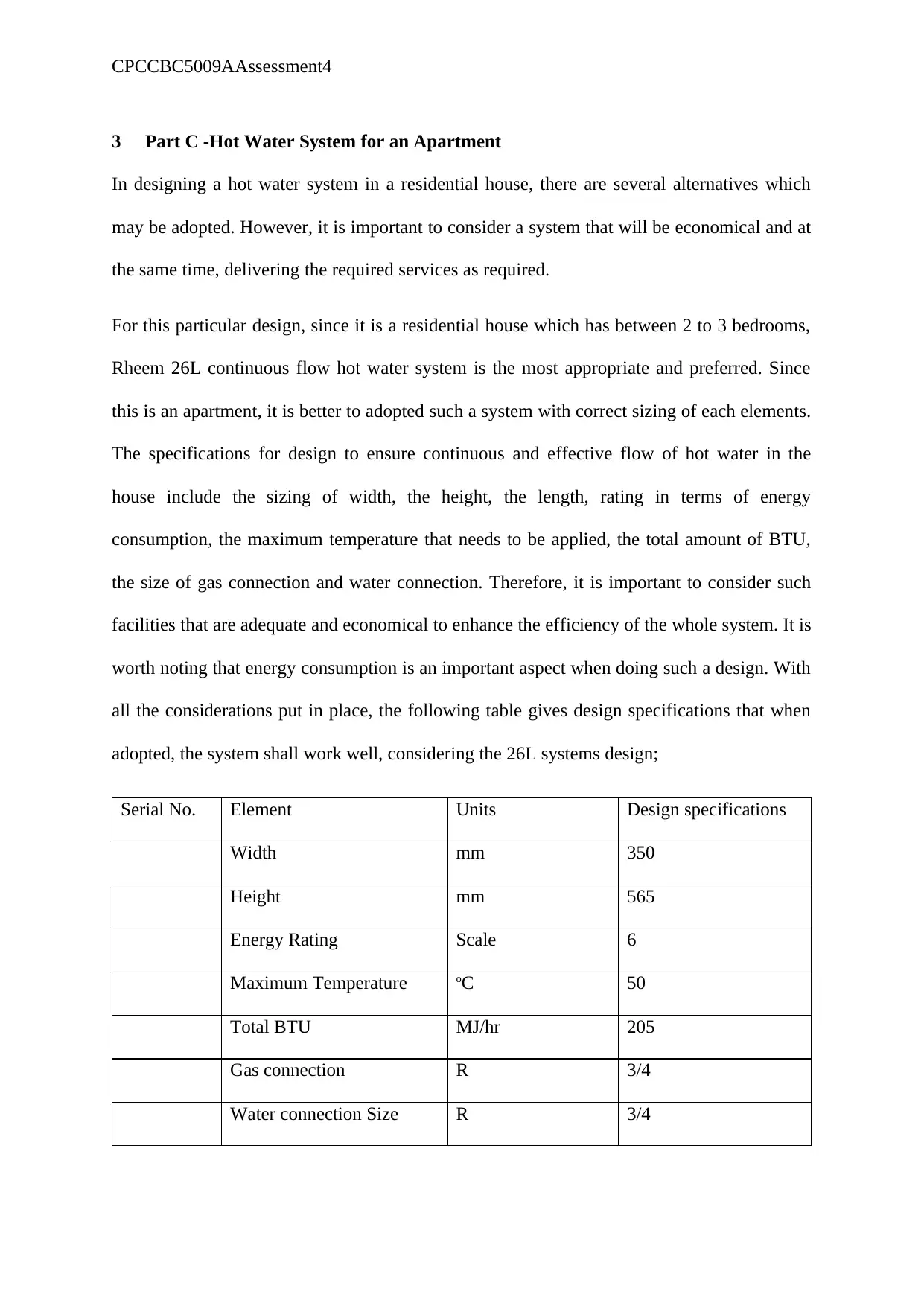
CPCCBC5009AAssessment4
3 Part C -Hot Water System for an Apartment
In designing a hot water system in a residential house, there are several alternatives which
may be adopted. However, it is important to consider a system that will be economical and at
the same time, delivering the required services as required.
For this particular design, since it is a residential house which has between 2 to 3 bedrooms,
Rheem 26L continuous flow hot water system is the most appropriate and preferred. Since
this is an apartment, it is better to adopted such a system with correct sizing of each elements.
The specifications for design to ensure continuous and effective flow of hot water in the
house include the sizing of width, the height, the length, rating in terms of energy
consumption, the maximum temperature that needs to be applied, the total amount of BTU,
the size of gas connection and water connection. Therefore, it is important to consider such
facilities that are adequate and economical to enhance the efficiency of the whole system. It is
worth noting that energy consumption is an important aspect when doing such a design. With
all the considerations put in place, the following table gives design specifications that when
adopted, the system shall work well, considering the 26L systems design;
Serial No. Element Units Design specifications
Width mm 350
Height mm 565
Energy Rating Scale 6
Maximum Temperature oC 50
Total BTU MJ/hr 205
Gas connection R 3/4
Water connection Size R 3/4
3 Part C -Hot Water System for an Apartment
In designing a hot water system in a residential house, there are several alternatives which
may be adopted. However, it is important to consider a system that will be economical and at
the same time, delivering the required services as required.
For this particular design, since it is a residential house which has between 2 to 3 bedrooms,
Rheem 26L continuous flow hot water system is the most appropriate and preferred. Since
this is an apartment, it is better to adopted such a system with correct sizing of each elements.
The specifications for design to ensure continuous and effective flow of hot water in the
house include the sizing of width, the height, the length, rating in terms of energy
consumption, the maximum temperature that needs to be applied, the total amount of BTU,
the size of gas connection and water connection. Therefore, it is important to consider such
facilities that are adequate and economical to enhance the efficiency of the whole system. It is
worth noting that energy consumption is an important aspect when doing such a design. With
all the considerations put in place, the following table gives design specifications that when
adopted, the system shall work well, considering the 26L systems design;
Serial No. Element Units Design specifications
Width mm 350
Height mm 565
Energy Rating Scale 6
Maximum Temperature oC 50
Total BTU MJ/hr 205
Gas connection R 3/4
Water connection Size R 3/4
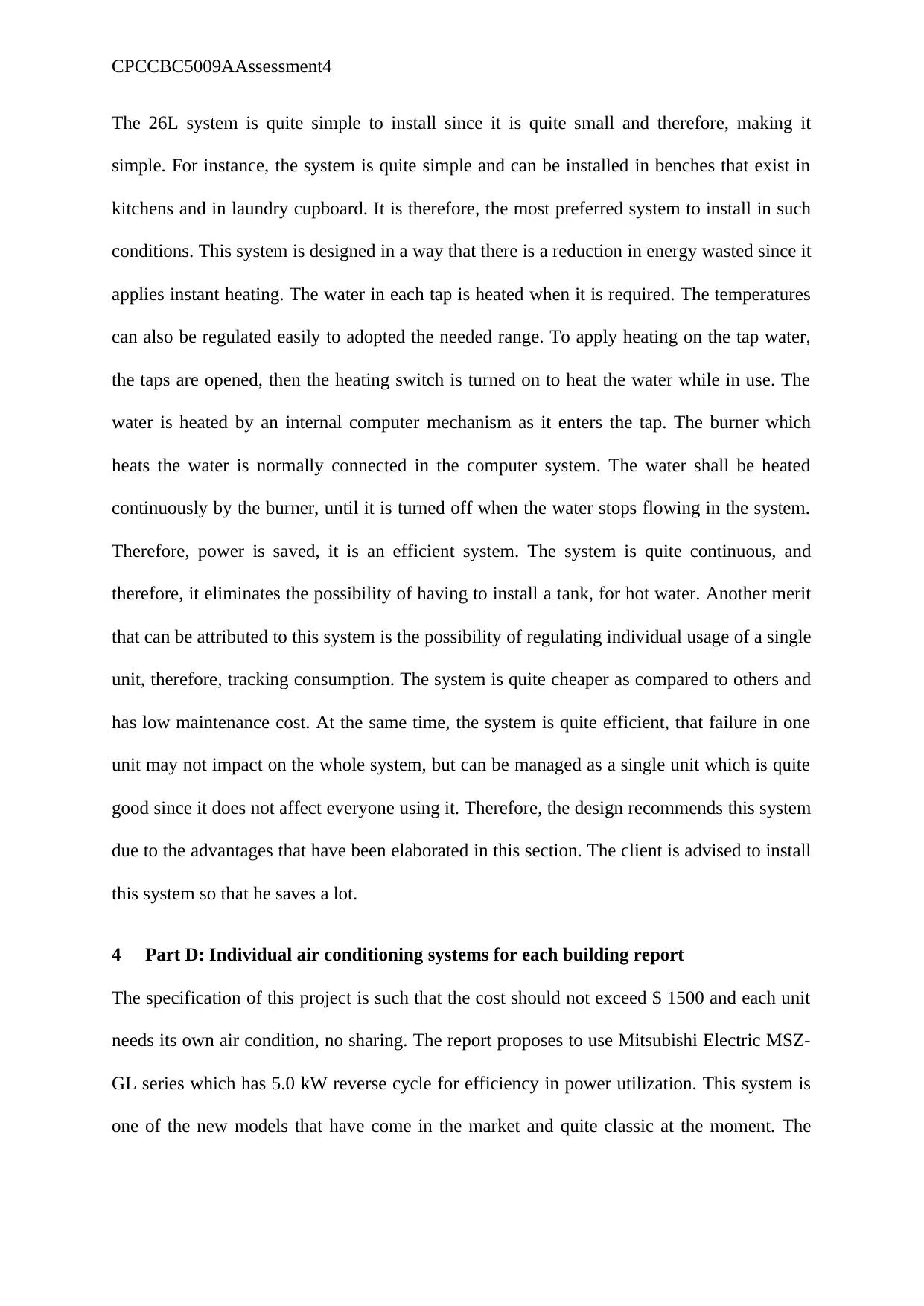
CPCCBC5009AAssessment4
The 26L system is quite simple to install since it is quite small and therefore, making it
simple. For instance, the system is quite simple and can be installed in benches that exist in
kitchens and in laundry cupboard. It is therefore, the most preferred system to install in such
conditions. This system is designed in a way that there is a reduction in energy wasted since it
applies instant heating. The water in each tap is heated when it is required. The temperatures
can also be regulated easily to adopted the needed range. To apply heating on the tap water,
the taps are opened, then the heating switch is turned on to heat the water while in use. The
water is heated by an internal computer mechanism as it enters the tap. The burner which
heats the water is normally connected in the computer system. The water shall be heated
continuously by the burner, until it is turned off when the water stops flowing in the system.
Therefore, power is saved, it is an efficient system. The system is quite continuous, and
therefore, it eliminates the possibility of having to install a tank, for hot water. Another merit
that can be attributed to this system is the possibility of regulating individual usage of a single
unit, therefore, tracking consumption. The system is quite cheaper as compared to others and
has low maintenance cost. At the same time, the system is quite efficient, that failure in one
unit may not impact on the whole system, but can be managed as a single unit which is quite
good since it does not affect everyone using it. Therefore, the design recommends this system
due to the advantages that have been elaborated in this section. The client is advised to install
this system so that he saves a lot.
4 Part D: Individual air conditioning systems for each building report
The specification of this project is such that the cost should not exceed $ 1500 and each unit
needs its own air condition, no sharing. The report proposes to use Mitsubishi Electric MSZ-
GL series which has 5.0 kW reverse cycle for efficiency in power utilization. This system is
one of the new models that have come in the market and quite classic at the moment. The
The 26L system is quite simple to install since it is quite small and therefore, making it
simple. For instance, the system is quite simple and can be installed in benches that exist in
kitchens and in laundry cupboard. It is therefore, the most preferred system to install in such
conditions. This system is designed in a way that there is a reduction in energy wasted since it
applies instant heating. The water in each tap is heated when it is required. The temperatures
can also be regulated easily to adopted the needed range. To apply heating on the tap water,
the taps are opened, then the heating switch is turned on to heat the water while in use. The
water is heated by an internal computer mechanism as it enters the tap. The burner which
heats the water is normally connected in the computer system. The water shall be heated
continuously by the burner, until it is turned off when the water stops flowing in the system.
Therefore, power is saved, it is an efficient system. The system is quite continuous, and
therefore, it eliminates the possibility of having to install a tank, for hot water. Another merit
that can be attributed to this system is the possibility of regulating individual usage of a single
unit, therefore, tracking consumption. The system is quite cheaper as compared to others and
has low maintenance cost. At the same time, the system is quite efficient, that failure in one
unit may not impact on the whole system, but can be managed as a single unit which is quite
good since it does not affect everyone using it. Therefore, the design recommends this system
due to the advantages that have been elaborated in this section. The client is advised to install
this system so that he saves a lot.
4 Part D: Individual air conditioning systems for each building report
The specification of this project is such that the cost should not exceed $ 1500 and each unit
needs its own air condition, no sharing. The report proposes to use Mitsubishi Electric MSZ-
GL series which has 5.0 kW reverse cycle for efficiency in power utilization. This system is
one of the new models that have come in the market and quite classic at the moment. The
⊘ This is a preview!⊘
Do you want full access?
Subscribe today to unlock all pages.

Trusted by 1+ million students worldwide
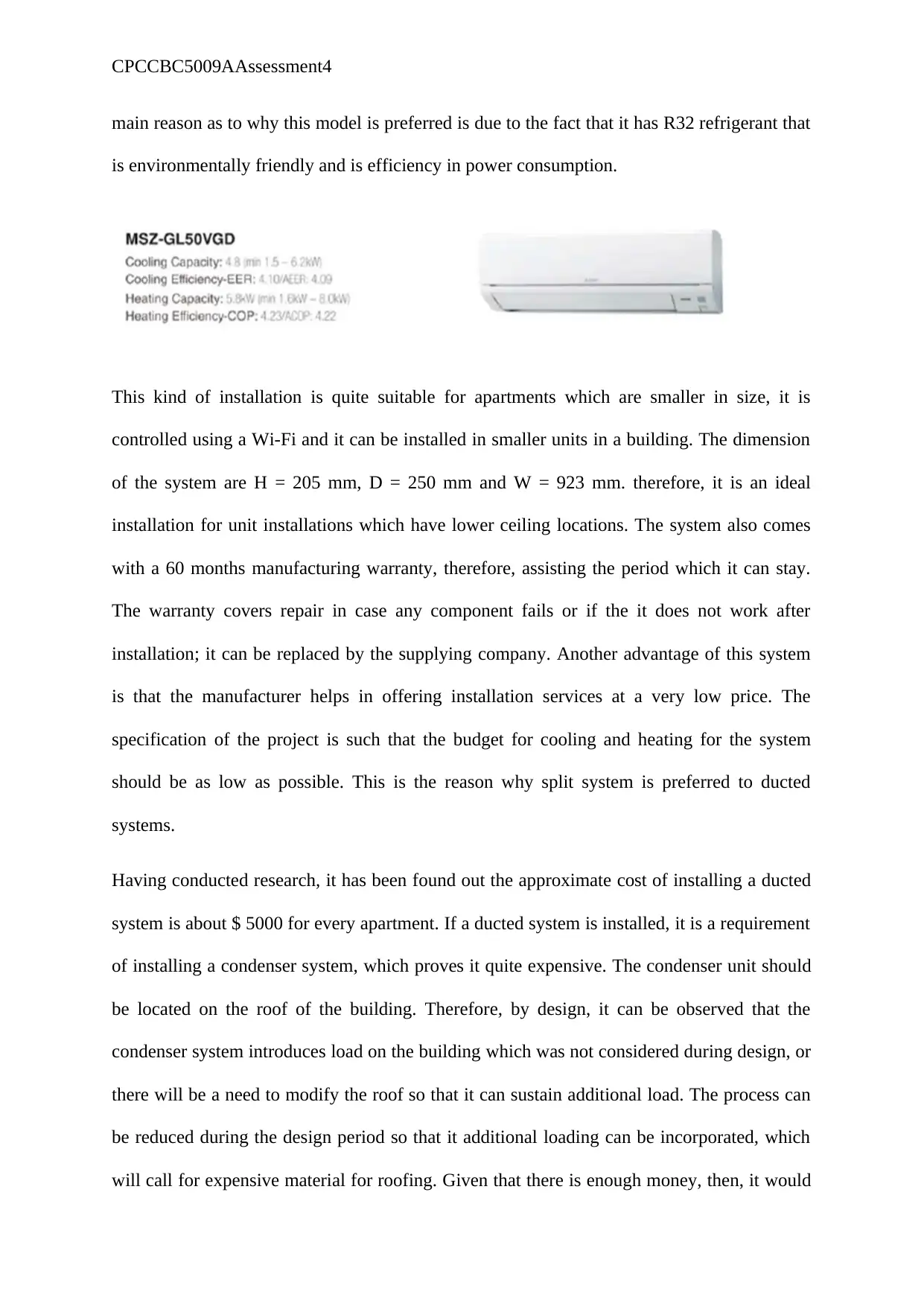
CPCCBC5009AAssessment4
main reason as to why this model is preferred is due to the fact that it has R32 refrigerant that
is environmentally friendly and is efficiency in power consumption.
This kind of installation is quite suitable for apartments which are smaller in size, it is
controlled using a Wi-Fi and it can be installed in smaller units in a building. The dimension
of the system are H = 205 mm, D = 250 mm and W = 923 mm. therefore, it is an ideal
installation for unit installations which have lower ceiling locations. The system also comes
with a 60 months manufacturing warranty, therefore, assisting the period which it can stay.
The warranty covers repair in case any component fails or if the it does not work after
installation; it can be replaced by the supplying company. Another advantage of this system
is that the manufacturer helps in offering installation services at a very low price. The
specification of the project is such that the budget for cooling and heating for the system
should be as low as possible. This is the reason why split system is preferred to ducted
systems.
Having conducted research, it has been found out the approximate cost of installing a ducted
system is about $ 5000 for every apartment. If a ducted system is installed, it is a requirement
of installing a condenser system, which proves it quite expensive. The condenser unit should
be located on the roof of the building. Therefore, by design, it can be observed that the
condenser system introduces load on the building which was not considered during design, or
there will be a need to modify the roof so that it can sustain additional load. The process can
be reduced during the design period so that it additional loading can be incorporated, which
will call for expensive material for roofing. Given that there is enough money, then, it would
main reason as to why this model is preferred is due to the fact that it has R32 refrigerant that
is environmentally friendly and is efficiency in power consumption.
This kind of installation is quite suitable for apartments which are smaller in size, it is
controlled using a Wi-Fi and it can be installed in smaller units in a building. The dimension
of the system are H = 205 mm, D = 250 mm and W = 923 mm. therefore, it is an ideal
installation for unit installations which have lower ceiling locations. The system also comes
with a 60 months manufacturing warranty, therefore, assisting the period which it can stay.
The warranty covers repair in case any component fails or if the it does not work after
installation; it can be replaced by the supplying company. Another advantage of this system
is that the manufacturer helps in offering installation services at a very low price. The
specification of the project is such that the budget for cooling and heating for the system
should be as low as possible. This is the reason why split system is preferred to ducted
systems.
Having conducted research, it has been found out the approximate cost of installing a ducted
system is about $ 5000 for every apartment. If a ducted system is installed, it is a requirement
of installing a condenser system, which proves it quite expensive. The condenser unit should
be located on the roof of the building. Therefore, by design, it can be observed that the
condenser system introduces load on the building which was not considered during design, or
there will be a need to modify the roof so that it can sustain additional load. The process can
be reduced during the design period so that it additional loading can be incorporated, which
will call for expensive material for roofing. Given that there is enough money, then, it would
Paraphrase This Document
Need a fresh take? Get an instant paraphrase of this document with our AI Paraphraser
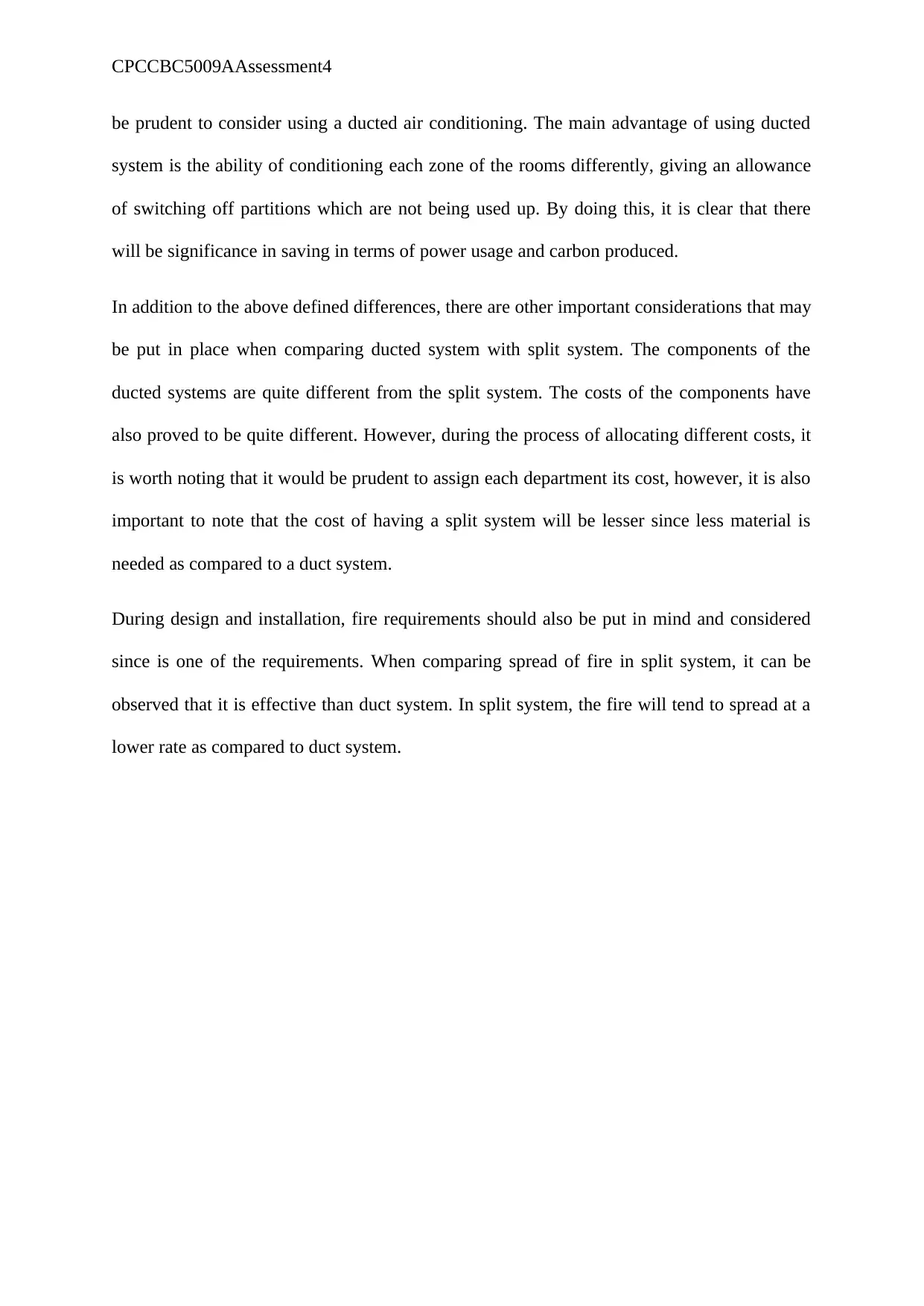
CPCCBC5009AAssessment4
be prudent to consider using a ducted air conditioning. The main advantage of using ducted
system is the ability of conditioning each zone of the rooms differently, giving an allowance
of switching off partitions which are not being used up. By doing this, it is clear that there
will be significance in saving in terms of power usage and carbon produced.
In addition to the above defined differences, there are other important considerations that may
be put in place when comparing ducted system with split system. The components of the
ducted systems are quite different from the split system. The costs of the components have
also proved to be quite different. However, during the process of allocating different costs, it
is worth noting that it would be prudent to assign each department its cost, however, it is also
important to note that the cost of having a split system will be lesser since less material is
needed as compared to a duct system.
During design and installation, fire requirements should also be put in mind and considered
since is one of the requirements. When comparing spread of fire in split system, it can be
observed that it is effective than duct system. In split system, the fire will tend to spread at a
lower rate as compared to duct system.
be prudent to consider using a ducted air conditioning. The main advantage of using ducted
system is the ability of conditioning each zone of the rooms differently, giving an allowance
of switching off partitions which are not being used up. By doing this, it is clear that there
will be significance in saving in terms of power usage and carbon produced.
In addition to the above defined differences, there are other important considerations that may
be put in place when comparing ducted system with split system. The components of the
ducted systems are quite different from the split system. The costs of the components have
also proved to be quite different. However, during the process of allocating different costs, it
is worth noting that it would be prudent to assign each department its cost, however, it is also
important to note that the cost of having a split system will be lesser since less material is
needed as compared to a duct system.
During design and installation, fire requirements should also be put in mind and considered
since is one of the requirements. When comparing spread of fire in split system, it can be
observed that it is effective than duct system. In split system, the fire will tend to spread at a
lower rate as compared to duct system.
1 out of 8
Related Documents
Your All-in-One AI-Powered Toolkit for Academic Success.
+13062052269
info@desklib.com
Available 24*7 on WhatsApp / Email
![[object Object]](/_next/static/media/star-bottom.7253800d.svg)
Unlock your academic potential
Copyright © 2020–2025 A2Z Services. All Rights Reserved. Developed and managed by ZUCOL.




